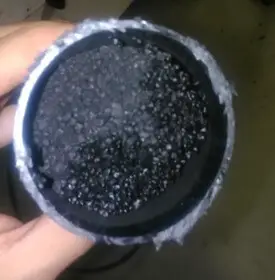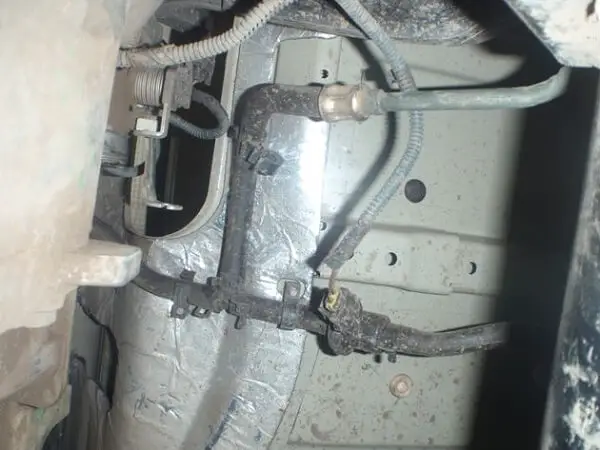The Gasoline fuel which one fills in gas vehicles consists of various hydrocarbons that are volatile Organic compounds (VOC).
These are organic chemicals with higher vapor pressure even at lower temperatures, which means it is highly volatile and tends to evaporate.
The fuel evaporation rate increases rapidly in hot temperatures. For example, if you have parked the vehicle under the hot sun, the fuel tank and its fuel temperature would increase and the fuel will start vaporizing.
If these vapors are not stored, then they would find their way and escape to the atmosphere, leading to wastage of usable fuel in addition to air pollution.
Hence vehicle manufacturers use an evaporative emission control system EVAP to store and control the gasoline vapors that are generated inside the fuel tank by using a charcoal canister, evap purge control valve, and other valves.
But many times, people face numerous vehicle-related problems due to a bad evap purge valve and think of deleting the evap purge valve or solenoid.
Can you bypass evap purge valve? The short answer is yes, but it needs to be done properly otherwise you may experience issues like engine emission failure, CEL (Check Engine Light) on dash, collapsed fuel tank, less fuel economy, engine misfire, jerky vehicle idle condition, vehicle starting problems, flooding of charcoal canister and fuel smell .
It is recommended to replace the bad purge solenoid with a new one instead of bypassing evap purge valve. These issues may vary depending upon the way in which the EVAP fuel system circuit and controllers are designed.
If you also have the doubt whether to bypass evap purge valve or not? and are looking for technical know-how, you are at the right place!
Here in this article, we will discuss this in detail and you will get some inference on the topic.
Table Of Contents
How Evap System Works?

Before we proceed further, it is essential to understand how the EVAP system works.
Instead of releasing the tank’s gas vapors into the outside atmosphere, the air vapor mixture is released into the charcoal canister.
EVAP system consists of various parts which are fitted in some sequence starting from fuel tank with a pressure sensor, pressure switching/bypass solenoid valve, charcoal canister, vent solenoid valve, purge control valve.
The gasoline tank is connected to a charcoal canister by a vapor hose through pressure switching or bypass solenoid valve.
One vacuum hose passes from the Canister to the engine air intake manifold via. purge control valve, which is controlled by an electronic control unit (ECU).
The purge inlet nozzle on the intake manifold is generally located just behind the throttle body butterfly valve.
During normal vehicle operation, fuel vapors that are generated inside the fuel tank are vented to Canister through a pressure switching solenoid valve and tank pressure control valve (TPCV).
EVAP canister adsorbs and stores these fuel vapors over its micropores of the activated charcoal particles and releases just hydrocarbon-free air to the atmosphere through the outlet’s ports of the canister.
Evap purge control valve decides when to apply engine suction vacuum to the canister for purging its stored gas vapors into the engine air intake manifold where the vapors mix with the main air-fuel mixture and participates in combustion.
When Does Evap Purge Valve Open?
The evap purge valve is normally closed and is controlled by an electronic control unit (ECU) of the vehicle which signals the purge valve to open and close.
In many of the old carburetor models, there used to be a mechanical purge valve that operates based on engine vacuum and throttle position.
But in modern vehicles, we have a fuel injection system with purging controlled by ECU.
Usually, ECU is programmed to give an Open signal to purge solenoid under certain favorable conditions of the engine running, such that engine tailpipe emissions will not get affected.
These conditions vary from vehicle to vehicle and it would depend on the purging strategy considered by automobile manufacturers.
Usual pre-requisite conditions followed by OEMs for purge valve activation are like,
1) When the engine coolant reaches the threshold temperature limit (say 185◦ F)
2) Once the percentage throttle opening exceeds certain values (say after 5%). Remember that the purge nozzle is located just behind the throttle butterfly valve.
3) As soon as the exhaust oxygen sensor gives an output value of 1 which gives closed-loop feedback about the oxygen percentage to the ECU to estimate the air-fuel ratio being burnt.
4) When Engine RPM is above 1000.
Whenever all of the above conditions are met, ECU sends a signal to open the purge valve.
It is worthwhile to note that the purge valve operates in a duty cycle which means it will not be continuously open, otherwise it would affect the engine’s air-fuel ratio.
When it happens, the engine’s suction vacuum will be applied to the canister thereby purging or pulling the vapors stored in the canister into the engine’s combustion chamber.
These conditions are selected such that the engine would be already running rich with fuel so an additional fuel enrichment by purging would not adversely affect the air-fuel ratio.
The impact would be negligible just like adding just a few drops of water to a pond is not going to affect the quantity of pond water.
Can You Bypass Evap Purge Valve?
People sometimes experience vehicle-related problems due to a bad evap purge valve and think of deleting it from the EVAP system. But only a few know that there is an option of cleaning the evap purge valve before resorting to bypassing it.
There are many reasons you would like to bypass evap purge valve or solenoid from the EVAP system, for example,
1) You notice a fuel smell coming from the vehicle due to a vacuum leak resulting from a bad purge valve.
2) While replacing the cracked or worn out vacuum hoses of the EVAP system you accidentally break down the nozzles of the evap purge valve and now want to get rid of the purge valve
3) Due to a bad evap purge valve and vacuum leak you may not be getting the required brake boost.
In normal vehicle operation, the air is supplied through an air intake system, and metered fuel is injected through the fuel injection system.
These two mixtures are then mixed in fixed proportion (Stoichiometric (14.7:1) air-fuel ratio) which is controlled by ECU through injector duty cycle (repeated ON and OFF) and percentage throttle opening input through the accelerator pedal.
When people talk about bypassing evap purge valve, you can derive 2 meanings from it.
In first method to bypass evap purge valve, you would be connecting the vacuum hose directly from the canister to the engine air intake manifold without connecting it through the purge valve.
In that case, unless you have an additional check valve in place to control the purging, the engine purge vacuum will be directly and continuously applied to the charcoal canister whenever the engine runs, thereby disturbing the stoichiometric air-fuel ratio which is detrimental to the engine operation.
In second option of bypassing evap purge valve you would need to simply plug the purge valve end of the vacuum hose which is connected to the intake manifold thereby isolating the purge valve from the EVAP emission control system.
We will discuss the probable effects of both scenarios in detail.
Connecting Vacuum Hose Directly From Canister To Engine Intake
Step 1
In this method you bypass evap purge valve, first remove the two vacuum hose connections of the purge valve, one is connected to the charcoal canister and the other is connected to the intake manifold. You may need to spray WD-40 to loosed the hose connections. A simple twist and pull shall remove the hose from teh purge valve
Step 2
Next, the hose which is connected to the charcoal canister needs to be connected directly to the intake manifold. You may need a new hose if the length of the hose is not sufficient.
Bypassing evap purge valve may lead to the following issues depending upon the valve interlocks and design.
1) Engine tailpipe emission failure
The canister stored vapors are purged and sent randomly or continuously to the engine for combustion.
Since canister purged vapors are nothing but a mixture of air and hydrocarbons this unmetered air-fuel mixture would affect the stoichiometric air-fuel ratio getting burnt in the combustion chamber in engine idle conditions.
This results in unburnt fuel (COx and NOx) exiting the engine tailpipe thereby would fail the engine emission test.
2) Check Engine Light (CEL)
ECU checks the integrity of the EVAP system circuit for vapor leaks by performing a series of leaking (small and large leaks) and venting tests by activating different EVAP system valves in a certain sequence for fixed intervals.
In the absence of a purge valve, the ECU through tank pressure sensor will not detect the required vacuum decay since the engine vacuum is continuously applied to the fuel tank while performing the integrity tests.
Hence it will not pass necessary tests and thereby illuminates the check engine light MIL on your dashboard.
CEL can also be triggered by several other issues, so it is better to check the DTC trouble codes using a diagnostic scan tool to be sure. This would be critical depending upon the emission regulations or mandatory SMOG test in your region.
3) Collapsed fuel tank
Usually, the evap purge valve is closed until it is activated by signals from ECU.
When ECU checks the EVAP system integrity check, it closes the canister vent solenoid valve during a large leak test, thereby the fuel tank vent line to the atmosphere is closed.
In this situation, the absence of a purge valve would mean, the entire manifold suction vacuum will get applied to the fuel tank and it would collapse.
You may sometimes hear a fuel tank collapsing noise if you notice carefully.
4) Less fuel economy
As explained earlier, since gasoline in the tank is highly volatile, when the engine vacuum gets applied to the fuel tank during EVAP integrity check, the evaporation rate of fuel increases, and these vapors traverse continuously to the intake manifold unnecessarily.
So the amount of liquid fuel remaining inside the tank at any given point in time will be comparatively less, resulting in fuel wastage
5) Engine misfire
If you bypass evap purge valve then you can expect engine misfire and jerky vehicle operation due to inconsistent air-fuel ratio.
This is because the unmetered air-fuel mixture will get into the engine through the canister vent port without any purging control.
You will experience that the vehicle is not accelerating fast enough as expected and the response probably would be weak and people will feel like the engine is not developing desired power and operating at reduced performance.
6) Jerky vehicle idle
In case of bypassing evap purge valve, purging would happen even during vehicle idling, wherein the engine will be running with lean fuel.
Any additional purging fuel enrichment would affect the air-fuel ratio badly and results in improper combustion of the fuel and jerky vehicle idle behavior.
7) Vehicle starting problem
You would feel that the vehicle is shaking and struggle to start since you have changed the metered air-fuel ratio set by the vehicle manufacturer.
Any interference with the air-fuel ratio would lead to the vehicle’s engine performance issues.
Plugging The Vacuum Hose Ends Of The Purge Valve
In this case of bypassing purge valve, purge vacuum hose end which is connected to engine manifold will be plugged and this may result into below issues. Need to check whether your vehicle experience these issues.
1) Check Engine Light
When ECU checks the integrity of the fuel system, the engine vacuum would not get applied to the EVAP system and will fail the EVAP integrity test which checks large vacuum generation during large leak tests.
You would get Check Engine Light MIL on the dash and unless you fix it, Diagnostic Trouble Code (DTC) tool will show error codes and prevent you from getting emission clearance.
2) Gas comes out of charcoal canister

The fuel vapors which are stored in the canister would not get purged out and keeps on getting accumulated until it gets saturated with fuel vapors.
Usually, a charcoal canister has a certain gasoline/butane working capacity (GWC/BWC).
When the charcoal canister gets filled with gas and the amount of gasoline vapors exceeds BWC, a breakthrough happens.
It means the fuel vapors directly exit the outlet port of the canister into the atmosphere thereby causing air pollution.
Once the canister gets saturated, the gas vapor condenses and turns into liquid gasoline which damages the canister charcoal particles by making it a fine powder.
Canister charcoal particles lose their porosity and become inefficient, you would need to replace the charcoal canister with a new one.
If the fuel system venting in your vehicle happens through the canister, then the breathing of the fuel tank would get affected and you would also notice gas tank overflows when filling.
3) Fuel smell and fire hazard
Due to vapor escape to the atmosphere, you would notice a fuel smell around your car and there would be chances of fire hazards associated with this.
It is worthwhile to note that, if you leave the vacuum hose end of the purge valve open to the atmosphere, then in addition to all the above problems, unmetered air would enter the intake manifold nozzle and it will affect engine performance & leads to an engine misfire.
Considering both above scenarios, it becomes necessary to use a purge valve in the EVAP circuit for getting desired vehicle performance and experience.
Instead of bypassing the evap purge valve, it is worthwhile to consider replacing the bad evap purge valve with a new one.
Conclusion
The Purge Valve is an important part of the EVAP emission control system to control, store and consume the fuel vapors which otherwise would get escaped into the atmosphere and creates air pollution.
EVAP Purge valve not only allows to purge the gasoline vapors stored in the charcoal canister but also ensures smooth vehicle performance during all driving conditions while purging under predefined operating conditions.
So it will not be wise to bypass evap purge valve from the evap emission control system.
Many times the root cause of the problem would remain in other areas but we tend to doubt parts that are not responsible because the symptoms of a bad purge valve coincide with the issues which occur when some other vehicle engine parts are faulty.
So it is not easy to differentiate the root cause of the problem. But with the above information in hand, hope you would probably take well-informed decisions by properly analyzing the issues faced and help in resolving your problems.
References
https://forums.nasioc.com/forums/showthread.php?t=2094802
http://volvospeed.com/vs_forum/topic/133009-purge-valveevap-canister-bypass/
https://www.saabcentral.com/threads/how-to-bypass-purge-valve.153808/
https://www.independentoffroading.com/index.php?threads/evap-canister-delete.86/
https://forums.genvibe.com/phpBB3/viewtopic.php?t=38210
Related Articles
Charcoal canister delete? Everything you need to know!
Can You Bypass Charcoal Canister? Let’s Find Out!
Can Purge Valve Be Cleaned? Everything You Need To Know!

